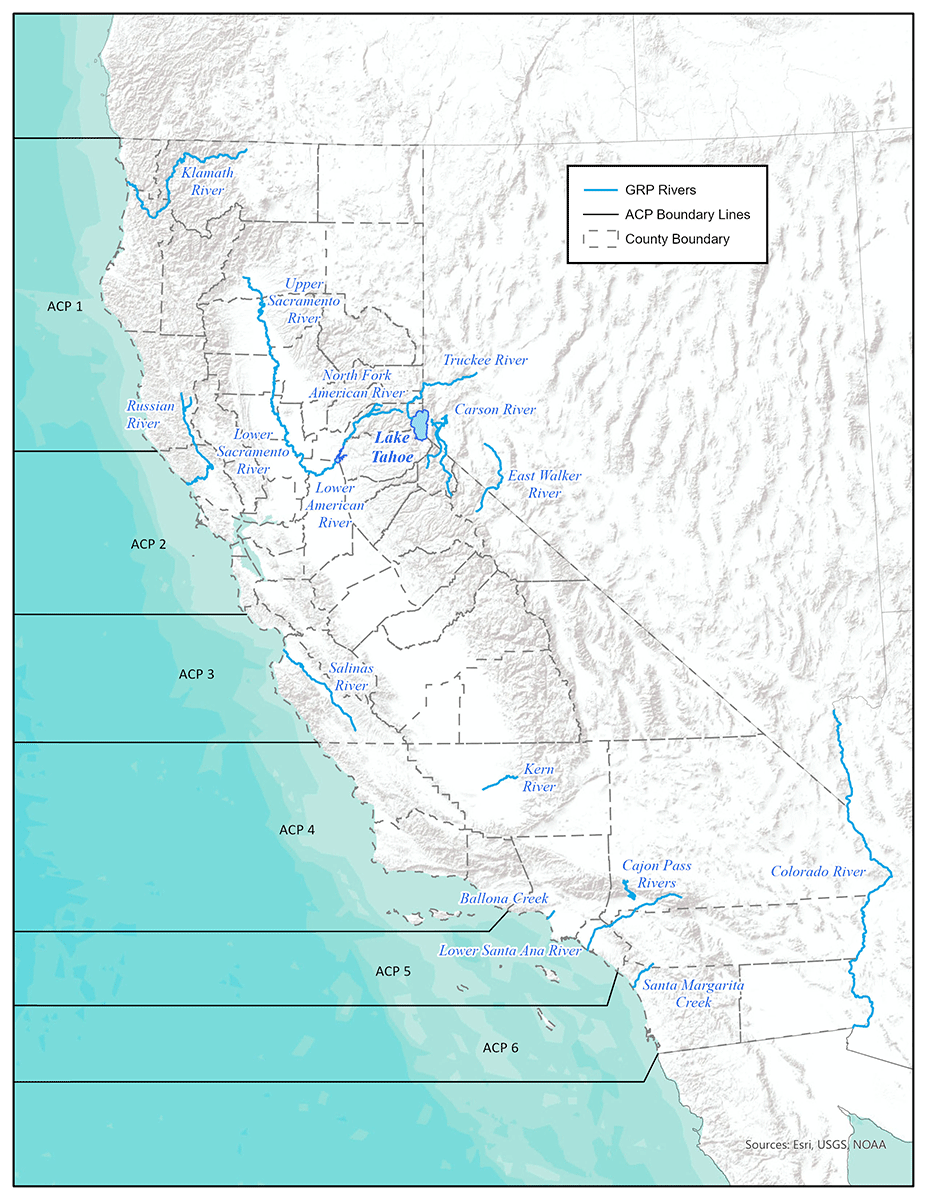Regional and California Contingency Plans
 ACP-GRP boundaries map - Click for larger image
ACP-GRP boundaries map - Click for larger image
Regional Response Team IX is responsible for ensuring:
- that state and federal resources are available when needed for emergency response to toxic spills within the states of Arizona, California and Nevada, and the 146 tribal nations located in those states; and
- that the multi-agency relationships and coordination systems exist to support these emergency response efforts.
The Regional Response Team IX Contingency Plan has been published to best support the deployment of those response resources:
The California State Oil Spill Contingency Plan (PDF)(opens in new tab) is an independent document regarding discharges of oil to all marine or inland surface waterways of California, and for oil spills to land. All state and local agencies must carry out spill response activities consistent with this Plan and other applicable federal, state, or local spill response plans.
Area Contingency Plans (ACP) for Marine Waters
The statutes (OPA 90 and SB 2040) enacted in consequence of the catastrophic oil spills of 1989, required contingency planning by both State and Federal Governments. The U. S. Coast Guard (USCG) and CDFW Office of Spill Prevention and Response (OSPR) agreed to joint preparation of six contingency plans through co-chairing the three Port Area Committees for Contingency Planning: USCG Port Areas for San Francisco, Los Angeles / Long Beach, and San Diego.
The Area Committee planning process is a proactive effort to deal with potential oil releases. It is open to all stakeholders and has involved representatives from over 50 agencies, including federal, state, local, industry and environmental participants. The three Port ACPs provide guidance for the first 24 hours of response, and each of the six coastal planning areas have provided detailed evaluation and recommendations for protection of regional shoreline resources. Shoreline Protection Tables (2013) (PDF)(opens in new tab) set forth planning requirements for shoreline protection for vessels in California's marine waters.
ACPs are updated on a regular schedule (currently every five years), and the respective Area Committees meet regularly to discuss lessons learned from spills, drills and exercises to inform updates to the ACPs. Between revision cycles, annual updates to the ACPs may be posted. The USCG released the Coastal ACP Handbook in 2025 which provides guidance for Area Committee planning and ACP standardization across the nation.
- Sector San Francisco Area Contingency Plans
- ACP 1 includes Del Norte, Humboldt and Mendocino counties
- ACP 2 includes Sonoma, Marin, Napa, Solano, Contra Costa, Alameda, Santa Clara, San Mateo, San Francisco, Yolo, San Joaquin, and Sacramento counties
- ACP 3 includes Santa Cruz and Monterey counties
- Sector L.A./Long Beach Area Contingency Plans
- ACP 4 includes San Luis Obispo, Santa Barbara, and Ventura counties and northern Channel Islands
- ACP 5 includes Los Angeles and Orange counties and southern Channel Islands
- Sector San Diego Area Contingency Plan
- ACP 6 includes San Diego County
Geographic Response Plans (GRP) for Inland Waters of the State
Geographic Response Plans (GRPs) are being updated and developed by OSPR in conjunction with other federal, state, and local government, industry and other partners for priority inland waters of the state with higher risk of an oil spill. GRPs will be driven by access to sites along river systems and lakes where response activities are feasible. The intention is that GRPs will be vetted through the regional Local Emergency Planning Committees (LEPCs) comprised of industry representatives, federal, State, and local government agencies, public health agencies, tribal representatives and other stakeholders, and may utilize local subcommittees to the LEPCs to provide further input and review of the GRPs.
- Ballona Creek Geographic Response Plan (PDF)(opens in new tab)
(Los Angeles County) - Updated Dec. 2024
- Cajon Pass Geographic Response Plan (PDF)(opens in new tab)
(San Bernardino County)
- Kern River Geographic Response Plan (PDF)(opens in new tab)
(Kern County)
- Klamath River Geographic Response Plan (PDF)
(Siskiyou, Humboldt, Del Norte Counties)
- Lower American River Geographic Response Plan (PDF)
(Sacramento County)
- Lower Sacramento River Geographic Response Plan (PDF)(opens in new tab)
(Shasta, Tehama, Glenn, Butte, Sutter, Colusa, Yolo and Sacramento Counties)
- Lower Santa Ana River Geographic Response Plan (PDF)(opens in new tab)
(Riverside and Orange Counties)
- North Fork American River Geographic Response Plan (PDF)(opens in new tab)
(Placer, El Dorado and Sacramento Counties)
- Russian River Geographic Response Plan (PDF)(opens in new tab)
(Mendocino and Sonoma Counties)
- Santa Margarita River Geographic Response Plan (PDF)(opens in new tab)
(Riverside and San Diego Counties)
- Upper Sacramento River Geographic Response Plan (PDF)(opens in new tab)
(Siskiyou and Shasta Counties)
- Geographic Response Plan Companion Manual (PDF)(opens in new tab)
- California, Nevada, Arizona Interstate Geographic Response Plans(opens in new tab)
- Public Participation - LEPC Meetings(opens in new tab)